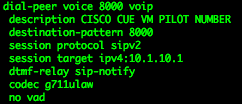While working with a Cisco UC560 setting up CME (Call Manager Express) and CUE (Cisco Unity Express) I came across an issue.
I had setup and registered my phones and extensions and all was well. I was able to make calls to and from internal phones.
While working to setup CUE and my first mailbox I ran into an issue. When pressing the “voicemail” button on our SPA504G phones we would immediately get a fast-busy signal.
After thinking through the call process I had to break things down 1,2,3 style. Pressing the “voicemail” button is exactly like dialing the extension that set for voicemail, in my case 8000.
Anytime you dial a number or a pattern of number you have to have a dial-plan to tell CME where to send those digits.
The UC560 has a built-in Service-Module Engine that handles CUE. It is much like a small server that lives within your UC Router.
This service-module engine is assigned an IP address and the router assigned a static route to reach the engine.


![]()
Without these important bits of configuration CUE will cease to exist. I will explain this in more detail a bit later.
So back to the issue at hand, the fast busy. Mentioning the need for a dial-plan, I noticed I had no dial-plan pattern that matched “8000” (voicemail extension). So I had to create one. Lets take a look:

The important factors to take away from this dial-plan are the following:
![]()
Which simply states “when the digits “8000” are dialed… send it somewhere… but where?
![]() That’s Where
That’s Where
Notice we are sending the SIP traffic to an IPv4 address of 10.1.10.1, does that address look familiar? Take a look back up at our Service-module IP address.
After creating this dial-plan, I picked up the phone, hit the voicemail button and much to my delight… I heard “Susie” the Cisco attendant, as I have named her, instructing me to setup my voicemail. Problem solved!
*Note:
Now back to those important parts of config. As I found out the hard way… Cisco does not support using the CLI to configure the UC560, they state using the CLI will void the warranty….PISH!
Cisco states that you must use the CCA tool. So do keep in mind that if you contact Cisco support (TAC) for this device they will only touch the CCA tool…. Also this support has been handed down to the Small Business department. Ugh!
However, what Cisco doesn’t know, wont hurt them! So I would alternate back and forth using the CLI and CCA.
Hope this helps!